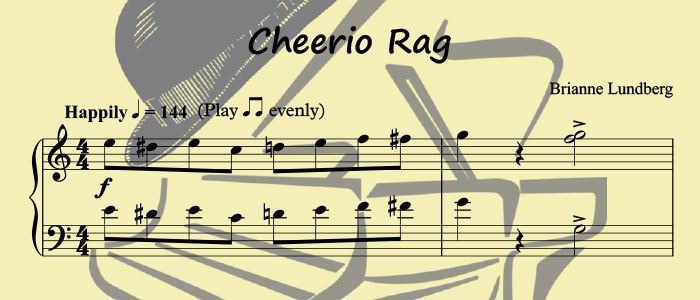Cheerio Rag: An Easy Ragtime Piano Solo
I've always loved ragtime music -- the syncopation, stride piano (perfect for lefties like me!), fun chromatic lines, the natural way it feels to play. I learned Scott Joplin's Maple Leaf Rag when I was just 11 years old, and it's still so fun to play!
However, there aren't many easy piano rags. Ragtime piano is generally too difficult for most pianists. But even while the syncopated rhythms and stride accompaniment require more practiced skills (and usually, giant hands!), I feel this style can be adapted for beginners just like any other.
This is what led to "Cheerio Rag": an original modern rag written so that piano students could have the chance to enjoy some easy ragtime piano sheet music!
"Cheerio Rag" is a late beginner to early intermediate ragtime piece in C Major. The rhythmic RH melody sprinkled with accidentals is accompanied by easy LH stride piano, altogether capturing that quintessential playful ragtime style we know and love.
The Story Behind the Music
Sometimes I am inspired by the most random things. "Cheerio Rag" is a perfect example of this because it was inspired by...a box of cereal.
"Cheerio Rag" came to life on a Saturday morning. I was unloading bags of food after a typical trip to the grocery store when I pulled out a certain well-known breakfast cereal box. As I glanced at the image of delicious oaty miniature doughnut-shaped bits, this music instantly popped into my head!
I hurriedly ran to my piano to record the music so I wouldn't forget it before I had time to write it down. (And then I ran back to my kitchen to save my perishable foods and put away the rest of the groceries.)
I know it sounds silly. Inspired by breakfast cereal?? Seriously? Yes, that is exactly how this easy ragtime piano piece came to be. I'm just lucky "cheerio" is a word as well as a brand, so I didn't have to worry about copyright issues when naming this rag after its source of inspiration!
Teaching Tools in "Cheerio Rag" Easy Ragtime Piano Solo
For all my compositions and arrangements, I include a list of "teaching tools" (educational elements). This helps piano teachers and students know what to expect and what they can learn from it.
Like many ragtime melodies, this one has chromatic patterns and accidentals. Most intervals in the melody are 2nds or 3rds (steps or skips), which makes it easy to follow. The syncopation is rhythmically interesting, but not overly complicated to play. And the classic ragtime intro style with parallel motion makes it easy to learn to read less familiar ledger notes in the LH.
The LH accompaniment mimics traditional stride piano but with much smaller intervals, mostly within a 5-finger position. The LH hand movement is relatively easy to follow and generally stays within the familiar range between Middle C and Bass C.
Staccatos and slurs are used to assist new readers of ragtime in understanding typical playing styles. For example, often the longer note values are played with slight separation between notes while the shorter note values and running passages are played more smoothly. Also, while LH stride is often played with separation between notes (mainly due to jumping across the keys), walking bass patterns may be played smoothly to help guide the direction of the music.
A Bite-sized Piece Gives You a Taste of Ragtime
Many pianists struggle with how long ragtime pieces usually are. If you've ever looked at ragtime piano sheet music, you know it's often at least 4 or 5 pages long because it includes several musical themes. This can be daunting for a first-timer or for anyone who just wants to play something short and sweet!
"Cheerio Rag" offers a taste of ragtime with just one main musical theme, presented over 2 pages with easy-to-read print size and comfortable spacing between notes (not too roomy, not too close together). Pianists who want to perform it for a ragtime piano solo (or who simply don't want it to end yet!) can use the repeat with 2nd ending. This "happy rag" is a great performance piece, too, and is sure to put a smile on both the performer's and audience members' faces.
It's Also Perfect for Small Hands!
So many smaller-handed pianists simply can't play ragtime because most ragtime piano music contains large intervals that are difficult or impossible to reach. So if you're looking for ragtime piano pieces for small hands, here you go! I made sure that the largest harmonic interval in "Cheerio Rag" is a minor 6th: well within reach of most pianists over the age of 6 or 7.
You'll find both sheet music preview and audio sample on the "Cheerio Rag" product page.
For more similar styles, check out current selections from the Rags, Jazz, and Blues sheet music for piano. More ragtime piano sheet music coming soon!



